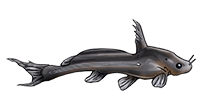Fishmandavew wrote: 03 Oct 2020, 08:59What size are the fish currently?
Whilst my instinct would be to say yes it should be a sexually dimorphic trait, my experience has never shown enough proof. Generally we buy small immature fish and tend not to recatch them to study once settled and sexing becomes easy in their home tank.
Best of luck breeding them.
One hobbyist suggested to me that they bred for him in the flow of a spray bar return or hang on weir filter return laying their eggs on the aquarium glass similar to Corydoras although I have never tried a setup attempt in this fashion and could not confirm if their eggs are indeed sticky enough for this to be true.
These fish are good sized already. 60mm or more SL.
I've bred the common banjo (
) several times (
https://www.planetcatfish.com/shaneswor ... cle_id=532) and I'm hoping to be as fortunate again. Those fish were egg scatterers; the eggs were very sticky, so I wouldn't be surprised if the person you mentioned found some eggs stuck to glass. My prediction would be that they found only a small percentage of the eggs, and the rest were scattered everywhere else in the tank.
In my experience, banjos need a little bit of height to the tank because they perform a vertical cycle of a dance while spawning. Considering the size of the new fish, I think they're large enough (or close to it) to start spawning once conditioned, but they are skinny and need to fill out.
As far as sexing, if I did get only 1 female (or male, depending on the direction of sexual dimorphism) in a group of 8 I will be frustrated. There were at least a 10 to 20 more specimens to pick from in the fish store. How could I get such a skewed group unless the holding tank was also skewed in its selection? Dang.
I don't recall my
B. coracoideus having different sized pelvics, although back then I wasn't photo documenting my fish as much as I do today. As you say, I'll need to track them to follow the development.
Cheers, Eric







